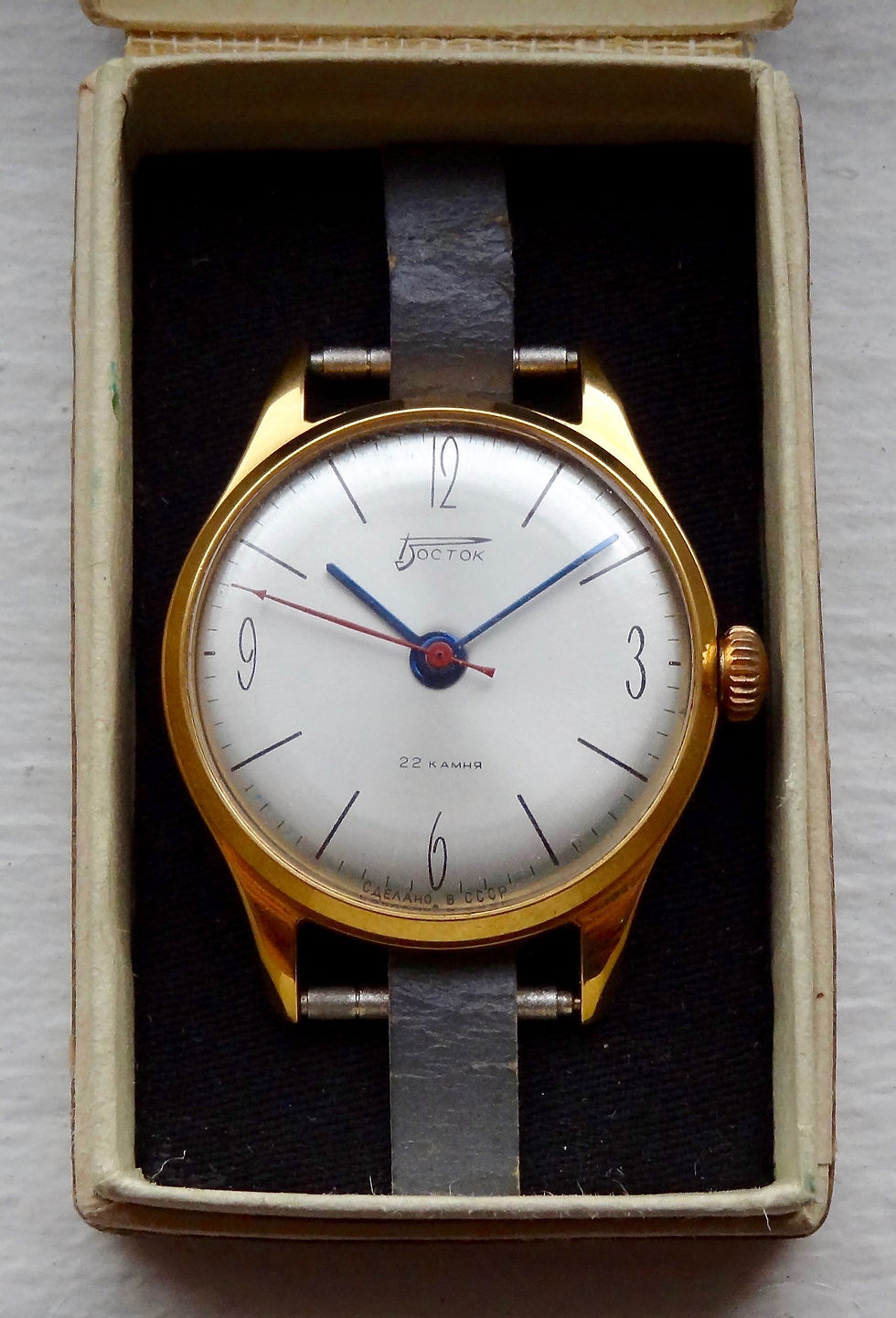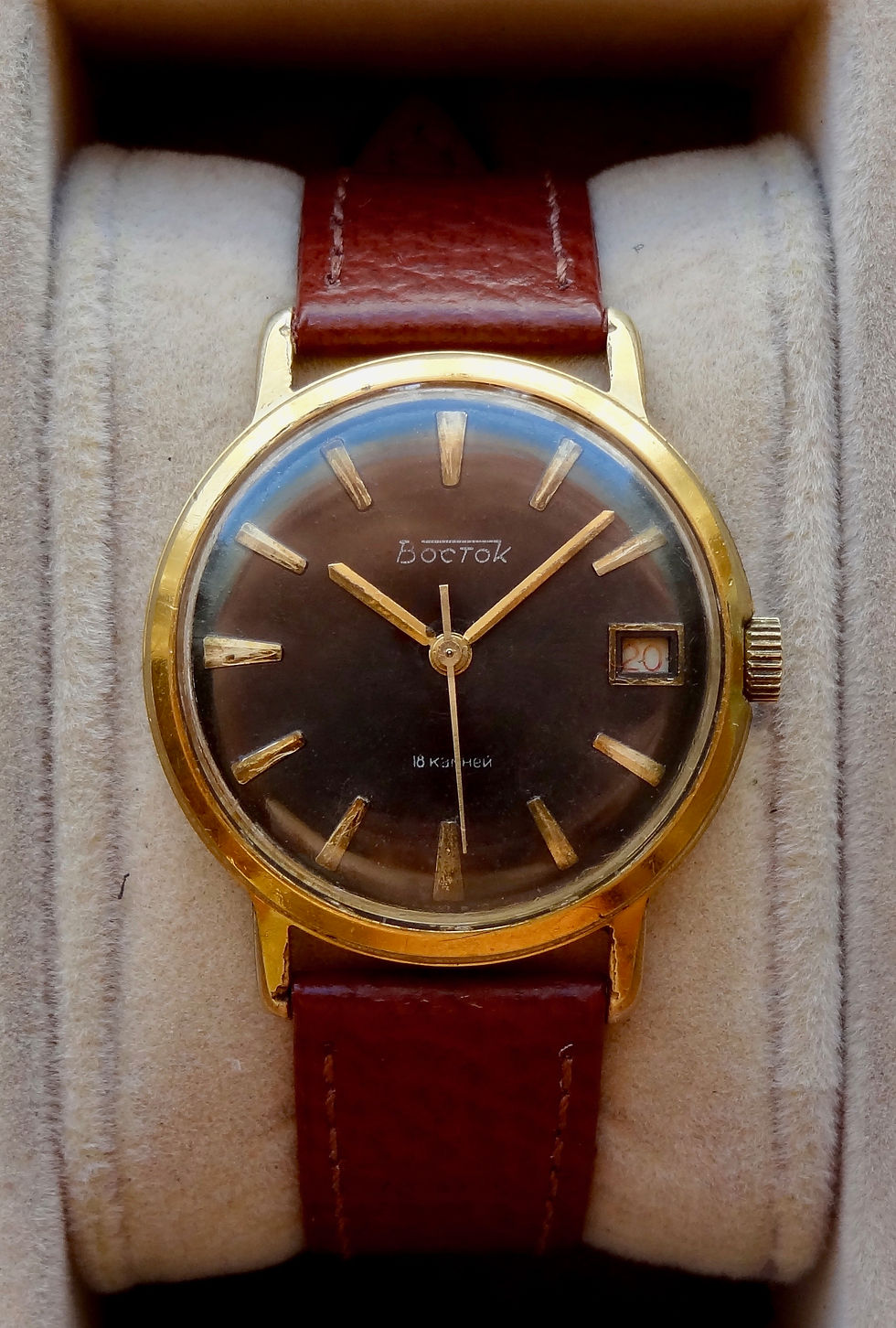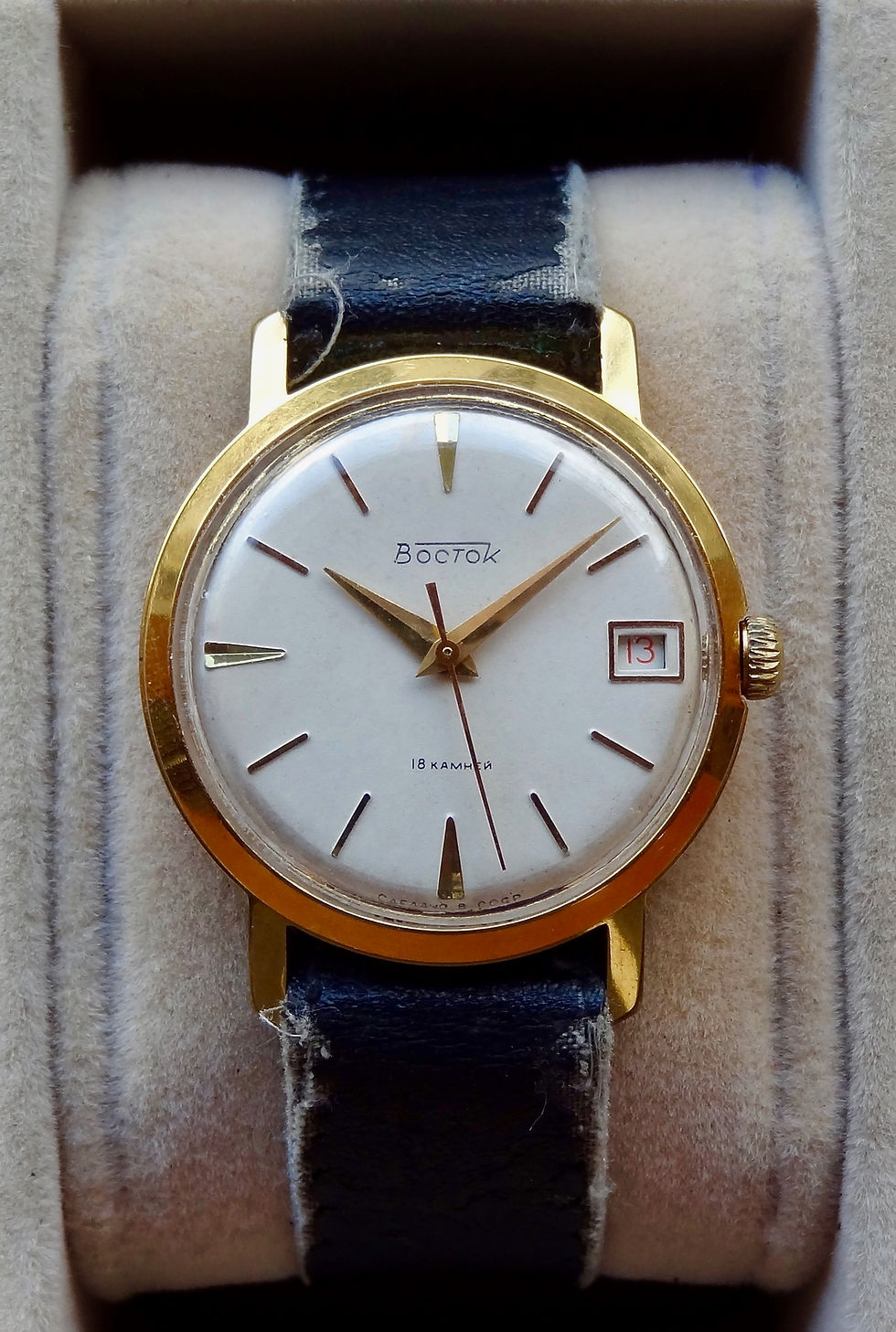Vostok / Восток
The first official mention of the Vostok brand (Восток, meaning "east") comes from the 1960 Watch Catalog, in which a precision-grade caliber is featured in two configurations. In 1962, these chronometer-grade timepieces would go on to win the gold medal at the Leipzig International Exhibition in East Germany. In all likelihood, the Vostok brand name was inspired by the Space Race.
However, despite the earlier usage of the name, it was until 1964 that the Chistopol Watch Factory was officially rebranded as "Vostok" with an accompanying logo redesign. Most watches produced after 1964 also bore the Vostok brand name on the dial.
In the second half of the 1960s, a project was undertaken to create a fully-waterproof watch, and by 1967, the design of the "Amphibian" was mastered. Mass production would soon follow. The standard civilian Amphibian was rated to a waterproof depth of 200 meters, while a special military version with a depth rating of 300 meters was later issued to some members of the Soviet Navy.
Beginning in the 1950s, and increasing rapidly in the 1960s, the export market comprised an important part of Vostok watch production. These watches featured dials written in English and the brand name of "Wostok" (in many languages, "W" is pronounced "V"). By 1972, Vostoks were exported to 54 countries worldwide.
The 1980s saw a sharp decline in quality, fit, and finish of nearly all Soviet watches. In this era of stagnation, an overall "cheapening" of parts was evident, movements lost their decorative flourishes, and case materials worsened (e.g. the thickness of gold-plating reduced from 20µm in the 1960s to <5µm in the 1980s). These signs of deteriorating quality continued until and through the collapse of the USSR in 1991.
Despite a particularly rocky period in the 1990s, when the factory was largely defined by disorganization and a lack of quality control, Vostok has in recent years partially regained its footing. The factory is one of the few remaining Soviet watch factories.

Caliber: 2809 (22 jewels) Model: ТУ 20Г/4, Design III Year: 1960s Notes: First chronometer-grade Soviet movement, Chistopol Watch Factory

Caliber: 2809 (22 jewels) Model: ТУ 20Г/4, Design III Year: 1960s Notes: First chronometer-grade Soviet movement, Chistopol Watch Factory

Caliber: 2809 (22 jewels) Model: ТУ 20Г/4, Design III Year: 1960s Notes: First chronometer-grade Soviet movement, Chistopol Watch Factory

Caliber: 2809A (22 jewels) Model: 061171 Year: 1960s Notes: Chistopol Watch Factory

Caliber: 2809A (22 jewels) Year: 1960s Notes: Export model, Chistopol Watch Factory

Caliber: 2809A (22 jewels) Model: 063190 Year: 1960s Notes: Chistopol Watch Factory

Caliber: 2809A (22 jewels) Model: 063190 Year: 1960s Notes: Chistopol Watch Factory

Caliber: 2809 (22 jewels) Year: 1960s Notes: First chronometer-grade Soviet movement, Chistopol Watch Factory

Caliber: 2809 (22 jewels) Model: 063169 Year: 1960s Notes: First chronometer-grade Soviet movement, Chistopol Watch Factory

Caliber: 2809 (22 jewels) Model: 063169 Year: 1960s Notes: First chronometer-grade Soviet movement, Chistopol Watch Factory

Caliber: 2809 (22 jewels) Model: 063169 Year: 1960s Notes: First chronometer-grade Soviet movement, Chistopol Watch Factory

Caliber: 2809 (22 jewels) Model: 061169 Year: 1960s Notes: First chronometer-grade Soviet movement, Chistopol Watch Factory

Caliber: 2809 (22 jewels) Model: 063170 Year: 1960s Notes: First chronometer-grade Soviet movement, Chistopol Watch Factory

Caliber: 2809 (22 jewels) Model: 063170 Year: 1960s Notes: First chronometer-grade Soviet movement, Chistopol Watch Factory

Caliber: 2809 (22 jewels) Model: 063170 Year: 1960s Notes: First chronometer-grade Soviet movement, Chistopol Watch Factory

Caliber: 2809 (22 jewels) Model: 063170 Year: 1960s Notes: First chronometer-grade Soviet movement, Chistopol Watch Factory

Caliber: 2809 (22 jewels) Model: 061170 Year: 1960s Notes: First chronometer-grade Soviet movement, Chistopol Watch Factory

Caliber: 2809A (22 jewels) Model: 061170 Year: 1960s Notes: First chronometer-grade Soviet movement, Chistopol Watch Factory

Caliber: 2809 (22 jewels) Model: 251170 Year: 1960s Notes: First chronometer-grade Soviet movement, Chistopol Watch Factory

Caliber: 2809 (22 jewels) Model: 253119 Year: 1960s Notes: Vostok Precision, incorrect second hand, Chistopol Watch Factory

Caliber: 2809 (22 jewels) Model: 251xxx Year: 1960s Notes: Vostok Precision, Chistopol Watch Factory

Caliber: 2809 (22 jewels) Model: 253xxx Year: 1960s Notes: Vostok Precision, Chistopol Watch Factory

Caliber: 2809 (22 jewels) Model: 251xxx Year: 1960s Notes: Vostok Precision, Chistopol Watch Factory

Caliber: 2809A (22 jewels) Model: 253xxx Year: 1960s Notes: Vostok Precision, Chistopol Watch Factory

Caliber: 2809 (22 jewels) Model: 253141 Year: 1960s Notes: First chronometer-grade Soviet movement, Chistopol Watch Factory

Caliber: 2809 (22 jewels) Model: 253xxx Year: 1960s Notes: Vostok Precision, Chistopol Watch Factory

Caliber: 2809 (22 jewels) Model: 253xxx Year: 1960s Notes: Vostok Precision, Chistopol Watch Factory

Caliber: 2809A (22 jewels) Model: 251060 Year: 1960s Notes: Chistopol Watch Factory

Caliber: 2809A (22 jewels) Model: 061172 Year: 1960s Notes: Chistopol Watch Factory

Caliber: 2809A (22 jewels) Model: 063172 Year: 1960s Notes: NOS, Chistopol Watch Factory

Caliber: 2809A (22 jewels) Model: 063xxx Year: 1960s Notes: Chistopol Watch Factory

Caliber: 2809A (22 jewels) Model: 061xxx Year: 1960s Notes: Chistopol Watch Factory

Caliber: 2214 (18 jewels) Model: 443205 Year: 1970s Notes: Export model (Sweden), Chistopol Watch Factory

Caliber: 2214 (18 jewels) Model: 283280 Year: 1970s Notes: Chistopol Watch Factory

Caliber: 2209 (18 jewels) Model: 123271 Year: 1970s Notes: Chistopol Watch Factory

Caliber: 2214 (18 jewels) Model: 441xxx Year: 1970s Notes: Chistopol Watch Factory

Caliber: 2214 (18 jewels) Model: 443106 Year: 1970s Notes: Chistopol Watch Factory

Caliber: 2214 (18 jewels) Model: 443106 Year: 1970s Notes: Chistopol Watch Factory

Caliber: 2214 (18 jewels) Model: 283106 Year: 1970s Notes: Chistopol Watch Factory

Caliber: 2214 (18 jewels) Model: 283267 Year: 1970s Notes: Chistopol Watch Factory

Caliber: 2214 (18 jewels) Model: 443267 Year: 1970s Notes: Chistopol Watch Factory

Caliber: 2214 (18 jewels) Model: 441267 Year: 1970s Notes: Chistopol Watch Factory

Caliber: 2214 (18 jewels) Year: 1970s Notes: Chistopol Watch Factory

Caliber: 2214 (18 jewels) Model: 283273 Year: 1970s Notes: Chistopol Watch Factory

Caliber: 2214 (18 jewels) Model: 283167 Year: 1970s Notes: Chistopol Watch Factory

Caliber: 2214 (18 jewels) Model: 283167 Year: 1970s Notes: Chistopol Watch Factory

Caliber: 2209 (18 jewels) Model: 153297 Year: 1970s Notes: Chistopol Watch Factory

Caliber: 2209 (18 jewels) Model: 153185 Year: 1960s Notes: Chistopol Watch Factory

Caliber: 2209 (18 jewels) Model: 151185 Year: 1960s Notes: Chistopol Watch Factory

Caliber: 2209 (18 jewels) Year: 1960s Notes: Vostok export, stainless steel case, Chistopol Watch Factory